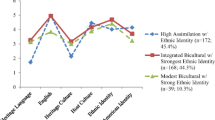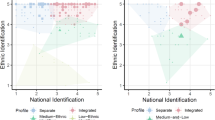Abstract
This study compares Latino host, Latino immigrant, Asian-American host, Asian-American immigrant and European-American host groups of adolescents with respect to four acculturation-related variables: ethnic identity exploration, ethnic identity affirmation/belonging, outgroup orientation, and American identity. Using the five ethno-generational categories as a grouping variable, we conducted analyses of 313 survey responses to the acculturation items at two time periods, 9 weeks apart. Results showed that differences among the three host racial/ethnic groups can best be explained by a group dominance perspective, whereby the two racial/ethnic minority groups are more similar to each other than they are to the European-American group. Furthermore, the relationship between American identity and ethnic identity components is stronger among the three host groups, as compared to the immigrant groups. Implications for future research with adolescent members of the host group whose heritage culture is non-European are drawn.
Similar content being viewed by others
References
Arends-Toth, J., & van de Vijer, F. J. R. (2003). Multiculturalism and acculturation: Views of Dutch and Turkish-Dutch. European Journal of Social Psychology, 33, 249–266.
Berry, J. W. (1990). Psychology of acculturation. In J. Berman (Ed.), Cross-cultural persepectives. Nebraska Symposium on Motivation (Vol. 37, pp. 201–234). Lincoln, NE: University of Nebraska Press.
Berry, J. W., & Kalin, R. (1995). Multicultural and ethnic attitudes in Canada. Canadian Journal of Behavioural Science, 27, 301–320.
Berry, J. W., Phinney, J. S., Kwak, K., & Sam, D. L. (2006). Introduction: Goals and research framework for studying immigrant youth. In J. W. Berry, J. S. Phinney, B. L. Sam & P. Vedder (Eds.), Immigrant youth in cultural transition: Acculturation, identity, and adaptation across national contexts. Mahwah, New Jersey: Lawrence Erlbaum Associates.
Berry, J. W., Trimble, J. E., & Olmedo, E. L. (1986). Assessment of acculturation. In W. J. Lonner & J. W. Berry (Eds.), Field methods in cross-cultural research (pp. 291–324). Thousand Oaks, CA: Sage Publications.
Bourhis, R. Y., Moise, L. C., Perreault, S., & Senécal, S. (1997). Towards an interactive acculturation model: A social psychological approach. International Journal of Psychology, 32(6), 369–386.
Capps, R., & Fortuny, K. (January 12, 2006). Immigration and child and family policy. Washington, DC: The Urban Institute. http://www.urban.org/url.cfm?ID-311362.
Judd, C. M., Park, B., Ryan, C. S., Brauer, M., & Kraus, S. (1995). Stereotypes and ethnocentrism: Diverging interethnic perceptions of African American and White American youth. Journal of Personality and Social Psychology, 69(3), 460–481.
Kwak, K., & Berry, J. W. (2001). Generational differences in acculturation among Asian families in Canada: A comparison of Vietnamese, Korean, and East-Indian groups. International Journal of Psychology, 36(3), 152–162.
Marcia, J. (1966). Development and validation of ego-identity status. Journal of Personality and Social Psychology, 3(5), 551–558.
Mummendey, A., & Wenzel, M. (1999). Social discrimination and tolerance in intergroup relations: Reactions to intergroup difference. Personality and Social Psychology Review, 3, 158–174.
Oyserman, D., & Sakamoto, I. (1997). Being Asian American: Identity, cultural constructs and stereotype perception. Journal of Applied Behavioral Science, 33(4), 435–453.
Phinney, J. (1992). The multigroup ethnic identity measure: A new scale for use with diverse groups. Journal of Adolescent Research, 7, 156–176.
Phinney, J. (2003). Ethnic identity and acculturation. In K. Chun, P. Organista & G. Marin (Eds.), Acculturation: Advances in theory, measurement and applied research (pp. 63–81). Washington, DC: American Psychological Association.
Phinney, J. S., Berry, J. W., Vedder, P., & Liebkind, K. (2006). The acculturation experience, attitudes, identities and behaviors of immigrant youth. In J. W. Berry, J. S. Phinney, B. L. Sam & P. Vedder (Eds.), Immigrant youth in cultural transition: Acculturation, identity, and adaptation across national contexts. Mahwah, New Jersey: Lawrence Erlbaum Associates.
Phinney, J. S., & Devich-Navarro, M. (1997). Variations in bicultural identification among African-American and Mexican-American adolescents. Journal of Research on Adolescence, 7, 3–32.
Phinney, J., & Ong, A. D. (2007). Conceptualization and measurement of ethnic identity: Current status and future directions. Journal of Counseling Psychology, 54, 271–281.
Pyke, K. (2005). “Generational deserters” and “black sheep”—acculturative differences among siblings in Asian immigrant families. Journal of Family Issues, 26(4), 491–517.
Renshon, S. A. (2005). The 50% American. Washington, DC: Georgetown University Press.
Rudmin, F. W., & Ahmadzadeh, V. (2001). Psychometric critique of acculturation psychology: The case of Iranian migrants in Norway. Scandinavian Journal of Psychology, 42, 41–56.
Rumbaut, R. N. (2004). Ages, life stages and generational cohorts: Decomposing the immigrant first and second generations in the United States. International Migration Review, 38(3), 1160–1205.
Rumbaut, R. N., & Portes, A. (Eds.). (2001). Ethnicities: Children of immigrants in America. Berkeley, CA: University of California Press.
Schlesinger, A. M. (1998). The disuniting of America: Reflections on a multicultural society. New York: W. W. Norton. Revised edition.
Sidanius, J., Feshbach, S., Levin, S., & Pratto, F. (1997). The interface between ethnic and national attachment: Ethnic pluralism or ethnic dominance? Public Opinion Quarterly, 61, 102–133.
Sidanius, J., & Pratto, F. (1999). Social dominance theory. New York: Cambridge University Press.
Staerklé, C., Sidanius, J., Green, E. G. T., & Molina, L. (2005). Ethnic minority-majority asymmetry and attitudes towards immigrants across 11 nations. Psicología Política, 30, 7–26.
Tabachnick, B., & Fidell, L. S. (2001). Using multivarariate statistics (4th ed.). Needham Heights, MA: Allyn and Bacon.
U.S. Census Bureau. (2003). U.S. Census 2000. Population and housing, SF1, SF3, and SF4files<www.census.gov>.
U.S. Census Bureau News. (May 10, 2006). U.S. Department of Commerce, Washington, DC. http://census.gov/Press-Release/www/releases/archives/population/006808.html.
Verkuyten, M. (2003). Ethnic in-group bias among minority and majority early adolescents: The perception of negative peer behaviour. British Journal of Developmental Psychology, 21, 543–564.
Verkuyten, M., & Thijs, J. (2002). Multiculturalism among minority and majority adolescents in the Netherlands. International Journal of Intercultural Relations, 26, 91–108.
Weisskirch, R. S. (2005). Ethnicity and perceptions of being a “typical American” in relationship to ethnic identity development. International Journal of Intercultural Relations, 29, 355–366.
Whitehead, K., Ainsworth, A., Wittig, M.A., Gadino, B. (2008). Implications of ethnic identity exploration and ethnic identity affirmation and belonging for intergroup attitudes among adolescents. Journal of Research on Adolescence, California State University, Northridge (in press).
Acknowledgments
The early phase of this research was supported in part by National Institutes of Health Grant (GM MBRS SCORE 5 S06GM48680-11) and the later phase was supported in part by NIH (GM MBRS SCORE 2S06GM48680-12A), both to the second author. We thank Andrew Ainsworth for data cleaning.
Author information
Authors and Affiliations
Corresponding author
Additional information
When describing the group membership of our participants we use the term “racial/ethnic.” This is not because we believe that the terms “racial” and “ethnic” are interchangeable. Indeed, we are aware that there is controversy about the legitimacy of the term “race” and that there is not widespread agreement about the meaning of the term “ethnic.” The five groups that compose our grouping variable include both racial groups and ethnic groups, as these terms are commonly used. Given all these considerations, we decided that a compound term was best.
Rights and permissions
About this article
Cite this article
Hsiao, J., Wittig, M.A. Acculturation Among Three Racial/Ethnic Groups of Host and Immigrant Adolescents. Am J Community Psychol 42, 286–297 (2008). https://doi.org/10.1007/s10464-008-9205-9
Published:
Issue Date:
DOI: https://doi.org/10.1007/s10464-008-9205-9




